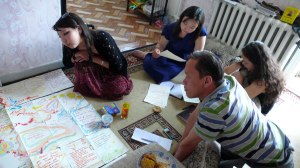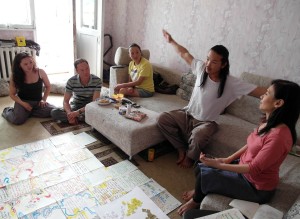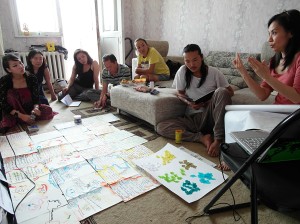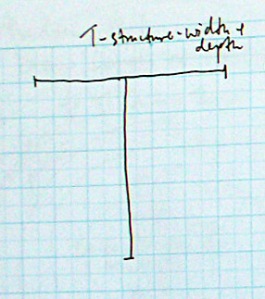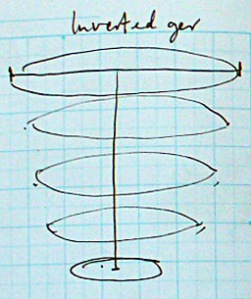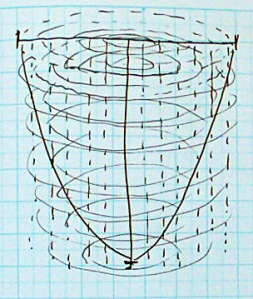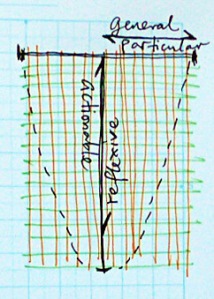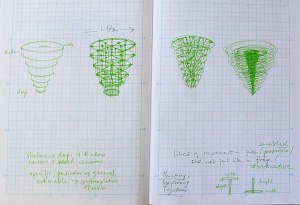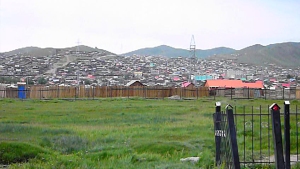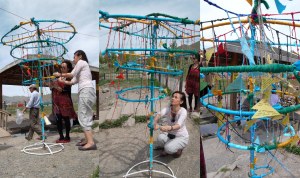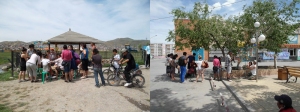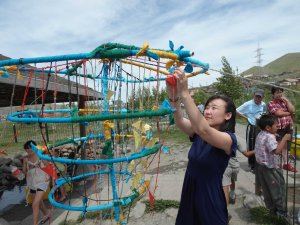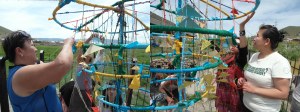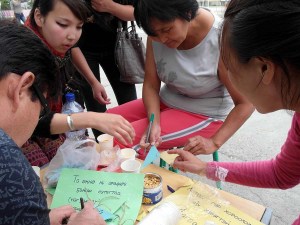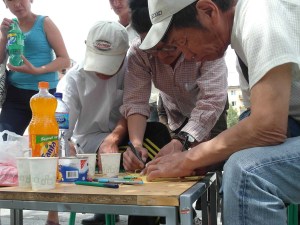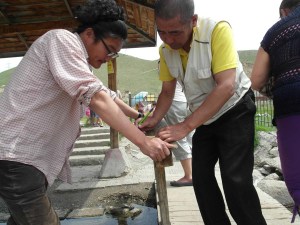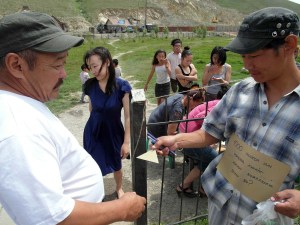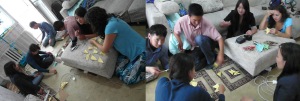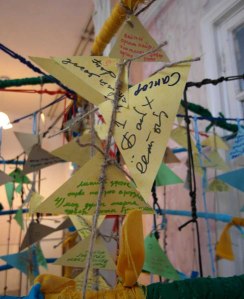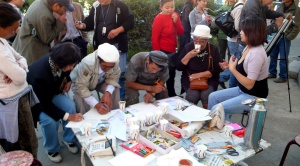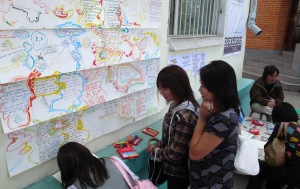The responses from Imagining Possibilities provided the initial orientation of ground for Thinking Together. Interested participants from OAU 2011 joined me in reflecting on and clarifying the meaning of the responses from Imagining Possibilities (see full participants list at end of post). From 13th June 2011, for over four weeks, we met for progressive discussions on the responses. The aim was to draw out certain orientations and alignments that would support what I call an envisioning of ground,[1] and generate further responses.
Envisioning of ground
In iFIMA’s work in Mongolia, the envisioning of ground involved several layered, complementary relational responsive activities and processes over a period of time, constantly adjusting and shifting with progressive interactions and contact. These began with our initial contact in 2006, which led to the Open Academy Ulaanbaatar activities in 2008, 2009 and 2011, and our immersive involvement in the daily life of Ulaanbaatar when we lived in rented apartments in the city. The posing of questions that triggers the imagination in Imagining Possibilities represented a concerted effort to capture the finer points of envisioning of ground through specific recorded responses given by people met during the public actions.
The ground that revealed itself shows Mongolians’ deep attachment to their traditional culture and their concerns of the implications of today’s fast paced development especially that brought about by mining activities. Mining is partly blamed for reduced and degenerating quality of grazing land for the traditional nomadic activities of herding. Mining creates a visible ‘opening up’ of the earth, an act of irreverence and injury to Mother Nature according to Mongolians’ nomadic cultural values.
Another issue of grave concern is Ulaanbaatar’s ger districts. Almost 40% of Mongolia’s 2.75 million inhabitants live in Ulaanbaatar.[2] Of this figure, around 60% of urban families live in ger districts. Harsh winters, diminished livestock or lack of work drive herders from the countryside to the capital. On arrival, most of them set up their ger in the city as they cannot afford to live in the apartments which are the main form of dwelling in the city. As they settle in, most would also construct an adjacent house that is generally built with minimal levels of insulation and high levels of ventilation heat loss, resulting in high heating needs in the winter.[3] Due to poor planning, the haphazard construction, plus a lack of regulations and services such water, electricity and sanitation, living conditions are very poor, as are safety and health. In addition to contributing to the problem of air pollution in the city, these districts are generally considered an eyesore in terms of the city’s appearance. There has been huge debate on the existence and problems posed by the ger districts to the city planning of Ulaanbaatar. Most ger dwellers hope to be able to leave the ger area and move into apartments in the nearest possible future, therefore reducing their motivation for creating a good environment in the ger areas.
The conversations: calibrative loops of communication and relational responsive exchange
Below are snippets of the conversations between participants that capture specific moments and points of exchange within a series of meetings and interactions over four weeks.
1st meeting 18 June 2011
Yuan: I have been studying the answers to Imagining Possibilities and I wonder why is it that most of the answers to the question “What can 10,000 Mongolians do to make a difference” are very broad and general, for e.g. “anything”, “everything”.
Uldii: Mongolians don’t say things directly. We have to think deeply what it means. There are 3 main kinds of traditions of thought in Asia. One like the Chinese philosophy is based on method, it is pragmatic. Tibetan thought is closer to magic or mysticism, and Mongolian thinking is very broad, not specific. For example, we begin with the year then progress on to say the month and date, from big to small. Western way is from small to big. It is a big problem for Mongolians to think small or concrete. The way your questions are phrased also leave a lot of room for interpretation.
Yuan: The questions were kept broad so that they are not overly direct or intrusive and leave room for the imagination. How will you rephrase the questions? Perhaps we could try answering the questions now and see how we would rework them.
Question one: “Imagine 1 most beautiful Mongolian word”
Answers given: Sex, fresh, love, universe, matter, echo, feelings
Question two: “Imagine where you will be in 10 years”
Answers: Everywhere, like the air. Married to a rich herder’s wife. Home.
Question three: “Imagine what 100 Mongolians are thinking about right at this moment”
Derme: 100 is too small
Uldii: 100 is not small, if you think that our total population is less than 3 million. For me, I would instead ask ‘What kind of Mongolian?’ Perhaps we can change the question to ‘What is 100 persons like you thinking about right now?’
Derme: If there are 100 Mongolians like me, the world will come to an end.
Dalkha: We can’t even know ourselves, how can we know others?
Yuan: Anyway let’s try to answer
Oyulbileg: Cooking… now it is 6 pm.
Silence
Yuan: Okay, let’s try question four, imagine what 1000 Mongolians can do to make a difference.
No answers.
Someone: Have to change the question. Is it a specific goal? In which area? The question is not clear enough.
Uldii: Organising some activity like teaching skills about how to decrease air pollution. Nomadic lifestyle is cause of air pollution. Ger wall is thin so its cold inside. To stay warm, people burn charcoal. Government is always focusing on issue of charcoal, but need to teach how to stay warm.
Derme: 1000 Mongolians can develop other urban centres or cities together, not only focus on Ulaanbaatar, so then it will be less congested. We need to open up alternative centres. There can be independent economies. Other answers: Build a building together. Plant trees or vegetables together. Clean something together. Run 1 km together.
Question six: Imagine what the world will remember about Mongolia in 10000 years.
Answers: Chinggis Khan. Ecological heritage. Nomadic lifestyle. Last nomadic nation before absorbed by the Chinese.[4] Traditional Mongolian custom and culture. Trying to revive old Mongolian culture of 10,000 years ago. Only Mongolian men are left in Mongolia, the women are all gone. Mongolia will be rich.
Derme: In future, there will be no boundaries between countries. In Mongolia, cities will be destroyed, we will have only nomadic lifestyle.
Uldii: In nomadic life, we do not have hospital, prison, school, but we are very happy. Schools made people more professional and technical, but we lost the general life.
Dalkha: I find this last question very interesting. I can go on thinking about this for days.
Yuan: How can we connect nomadic thinking and practice with other practices in the world?
Uldii: Western development is too much, will come to point of destruction, so the point is to find balance.
Yuan: Can we and how can we make nomadic culture and knowledge work within modern structures and systems?
Uldii: Nomadic culture is very flexible. We just need to know the weather by seeing the sky and honour iconic things and the household.
Jay: For example, if 1000 people want to practice living a nomadic lifestyle, but the mining companies now control the land. How will it work?
Movement and calibrations
The responses generated a series of ‘orientating views’ of the ground, and invoked the participants’ minds and imagination to orientate and find alignments in relation to their social and cultural issues and in relation to their fellow Mongolians. The relational-responsive activity within the conversations involved multi-directional and multi-focal movement (roaming, broadening or zooming out, picking up certain points of focus, narrowing/ zooming in, assessing, make connections between the various elements) which worked to re-orientate, re-focus, clarify and fine tune both the questions and the answers. In responding to each question and each other, each participant was in the active receptive mode – attentively listening, reading, and evaluating (e.g. weighing, scanning, sizing, comparing). As we agreed and disagreed with each other, alignments and re-alignments were drawn and redrawn, orientations get sharpened, judgements are calibrated and a collective sense of direction(s) emerges. The values and thoughts of others form the ground for manoeuvring orientation/re-orientation and alignments/re-alignments. This activities involve a roaming attentiveness, a mode of perception that Kester calls at once ‘anticipatory and open’, as well as ‘intensely focused and attuned’ (Kester, 2011: 152).
The first meeting ended with the idea of forming a learning and discussion club, like an informal academy of nomadic knowledge. I suggested we can start by asking the question: how does nomadic knowledge contribute to and work with modernisation? The group were supportive of this idea. This would be an ‘actionable idea’.
Moving on
In the second round of conversations on 21 June 2011, tensions between ger and apartment dwellers were raised and discussed, capturing and re-orientating our thoughts around this tension. The group began to feel more comfortable discussing ideas together and moving forward towards ideas of collaborating on a joint activity together.
After the first two rounds of conversations, I started to develop a visual component that could add to the conversations – to clarify and carry the ideas further. I thought of a spatial installation that incorporates a ground for orientation, negotiation, and movement; a space which alludes to the form of what the participants have expressed as the ‘Mongolian way of thinking’, which participants described as broad and deep. A space that reflects this breadth and depth would take the shape of a T. In a 3-dimensional form, this is like an inverted ger. The entire space is charged with lines for locating particular thoughts or ideas, divided along axis or into areas that are given specified values by the participants. For example, along the horizontal, the ‘unspecific’ or ‘generalised’ position could be marked on the outer circumference and the ‘specific’ position in the centre. Moving an expressed idea towards the centre would mean making it more specific. The vertical axis could work as going downwards to be more ‘reflective’, and going upwards to be more ‘actionable’. This contributes to a sense of movement of thoughts and ideas – by sliding them in various directions, one is exploring new possibilities. Rather than delineating ideas into binaries, the multiplicity of points opens up a range of different ways of seeing and valuing. This spatial installation then acts as a ‘field-ground’ that allows for the exploration and envisioning of different possibilities and facilitate the activity of tapping into or drawing from nomadic culture and knowledge. Although this culture is a very deep well, a rich resource; unless we are able to draw from it to address the problems of city living and systems that Mongolia is facing today, it would be an unyielding well.
Sketches for developing the idea of the ground-space
Sketches on the possible forms of the ground-space sculpture-installation
Actions in public spaces 3rd July 2011
Two actions took place, one in a ger district and the second in an apartment area. It was important to bring our action to both ger and apartment areas as they represent the two sides of the divide over the preservation or abolition of the ger district. As one of the participants (who lives in a ger district) states bluntly: “Ger district dwellers hate (and envy) apartment dwellers and apartment dwellers hate ger district dwellers”.
Top: The ger district seen from the Dari-Ekh spring; Bottom: cleaning the site before the action
Setting up the Thinking Together sculpture-installation at Dari-Ekh (Photographs on left and centre by Ganzug)
Interactions at ger district (left) and apartment area (right). Photograph on left by Ganzug
Oyulbileg tying responses onto the installation
Participants taking the time to really consider and respond to the questions
Enkbold (top left) and Chinzorig (bottom right) engaging with people at Dari-Ekh
Apartment resident reading the responses from ger residents, Tseika is on right
The questions were posed by the five participant-collaborators who actively interacted and conversed with people from the ger and apartment areas. The questions were:
Enkbold: Are ger districts necessary in Ulaanbaatar? If yes, why? What can be done to improve the situation in ger districts? If not, why?
Zaya: How can we protect the spring water in Dari Ekh?
Muji (representing Nomad Wave): Would you like to live in (or to return to) the countryside and why?
Mungen: What will happen if 10,000 Mongolians move to the city tomorrow?
Chinzorig: What can 1,000 Mongolians do to bring about happiness?
On the day of the actions, responses written on colour-coded cards and tied at random positions onto the installation due to the lack of time for reflection and discussions. The collaborators got together on 4th July, the following day, to negotiate the different responses, orientate around them, and negotiate with each other as to where each response should be located on the sculpture-installation. They reviewed all the responses – discussed, clarified, evaluated and negotiated with each other, as well as with the ground that the responses opened up, and determined how they should be located within the metaphorical ground-space of the sculpture-installation. They had to decide with what criteria they would evaluate the responses and how they would use them to create a field of related and relational views, placed in revisable relational positions with each other. This would bring us full cycle right back to the activities that took place at the start of our four-week interactions – clarifying the answers, testing, relating, connecting and developing a sense of alignments and possible actions from them.
Discussions in re-negotiating the responses from 3 July actions
This is their selection of the responses they found most interesting and significant.:
To the question: Are ger districts necessary in Ulaanbaatar?
– Yes ger districts are necessary, because Mongolian people need to be touching the ground. However, ger districts need to be developed. Every Mongolian need to work together to develop this area.
– Yes ger districts are necessary because people should not live in the streets.
– Necessary because our tradition come from our ancestors, so we have to respect our tradition.
– It’s necessary because there are very poor people living in the tunnel (underground sewage tunnels)
– We need to be in apartments because ger districts are dirty and there are too many drunken people.
– In ger districts, there are problems of trash, air pollution, the streets are dark and bad things happen. Government has to solve the problem, make better lighting and have a police station nearby.
To the sub-question: What can be done?
– When people agree, they can combine to build one apartment block together.
– Together we can do everything.
– For example, we can make the area look more tidy and uniform, every fence can be in same colour, make it look nicer and influence the city planning.
– The public, the government, Mongolian society and the President should solve the problems because it is their responsibility.
– We have to move ger districts to the south.
To the question: How can we protect the spring water in Dari Ekh?
– Don’t use pot to pull out water from the spring, don’t leave trash. People can pick up trash and clean the well together.
– We have to keep our environment clean. If there is trash we should take it away.
– The most important thing is clean environment.
Mongolian president should protect the spring.
– We need to set up night watch. If any organisation leave their trash here, people should move the trash far from the spring.
To the question: Would you like to live in (or to return to) the countryside and why?
– No, in rural areas there are no job positions, so I have to be in the city.
– I want to live in the countryside, because of the fresh air and environment
– Of course I would like to return to nature.
– Yes, but because of life problems I have to live in the city, but if the provinces can develop like the city, I’d like to return.
– No, because life conditions there are bad.
To the question: What will happen if 10,000 Mongolians move to the city tomorrow?
– That would be the biggest tragedy because our Motherland is very big and it shouldn’t happen.
– It’s necessary for the Motherland that families stay together, then the liver is full (Mongolian phrase meaning completion).
– We have to manage the movement of people from the countryside.
To the question: What can 1,000 Mongolians do to bring about some happiness?
– Build a lot of apartments together.
– Encourage each other.
– Contribution of mind.
– Combine each person’s 21,000 Togrogs from the government and buy something big. (Every Mongolian citizen gets 20,000 Togrogs as welfare payment from the government each month, roughly equivalent to £10)
– 1,000 people can combine together to give smiles and love.
– Have to make the orphans and the poor happy.
– We can make people happy in a lot of ways, for e.g. by mind, action and skill. We can create buildings, statues, plant healthy vegetables, plant grass in the desert, create forests. We have the power of ‘holding the mountain and stirring the water’ (Mongolian expression of great power).
Repositioning the re-negotiated responses onto the Thinking Together installation
The process of negotiation needs to create repeated interactive and performative experiences that could form feedback and conversation loops with one’s entrenched values and the knowledge that sustains one’s dispositions. Participants’ different backgrounds, upbringing and experiences have given them a stock of values and knowledge, perhaps best termed as worldview, a way of facing the world (from which to judge others and the world, informing their conduct, behaviour, and manners of speech). Worldviews are finely cultivated, it is a form of knowledge that sustains one’s orientational bearing. Worldviews are sustained by sets of values and judgements, which are encoded in social and cultural practices, literature, folk stories, mores and forms of representation; they are passed from generation to generation, in socialisation processes with others[5]. When bias and assumptions exist, they would be reflected in and inform one’s worldview.
The Thinking Together installation acts like a clue rather than a cipher, in the senses of Tim Ingold’s (2000) distinction. A cipher provides one a readymade answer, a clue demands that one ventures on a journey to find the answer[6]. Clues encourage movement; ciphers dull it; just as taken-for-granted stock of knowledge and knowledge-as-formula stifles exploration and negotiation. Clues act in calibrative/ oscillative interplay between what the people already know and what they need/want to find out. I think the Thinking Together/OAU experience managed to stimulate the participants’ re-orientations towards the ground of their movement, prompting them to find new alignments and to search for ways to connect with their fellow Mongolians, as demonstrated by the projects which were conceived and run by the participants as the final round of activities of OAU.[7]
Through relational responsiveness, durational involvement and the calibrative fine tuning that was ongoing throughout Thinking Together, thoughts and ideas that were different to one’s own acted as clues and led one towards a journey of exploration. The various activities and components in this durational negotiation process – conversations, active imagining, acting and responding, proposing and posing imagined scenarios,[8] intervals, and a visual and interactive interstitial time-space – collectively constituted negotiation-as-active-knowing. It provided opportunity for the Mongolian collaborators to negotiate with and to define what is ‘actionable’ and ‘specific’ for them. For Jay and me, it was to negotiate ways of working and thinking that complicated our known and honed ways of organising via planning and rational analysis – our expertise – the basis on which we were invited to conduct OAU in the first place. The durational process of negotiation-as-active-knowing, I hope, is able to provide a time/space for facing difference, relationally responding to it, considering, evaluating and testing it, allowing each participant to calibrate, improvise and evolve their own ‘right’ way .
Negotiation-as-active-knowing [9] challenges our taken-for-granted assumptions and entrenched, unchallenged knowledge. Encounter with difference shakes one out of complacency. In order to engage someone in such a process, the challenge remains how to establish a sense of ‘why is this related to me?’ or ‘why should it concern me’ (Fromm 1959). I believe as Shotter (2005) says, in interactive exchange, there is a non-rational obligatory relational responsive behaviour between people, because of the chiasmic structures of our lives, even though there may be no ‘rational’ reason to do so. However, the process of a social art project and creative community arts can encourage and increase a sense of relatedness, curiosity, imagination and improvisation, through imaginative conversations, interactions, activities and conviviality within a project.
The interactions in OAU resulted in an increased sense of certainty and knowledge on how to face and work with somewhat bewildering and perplexing otherness. As the process of negotiation-as-active-knowing increases one’s sense of certainty and possibility for movement, this sense of movement feeds back and infuses attitudes towards contact and ground, possibly modifying and re-aligning the artist’s and co-negotiators’ previously held perceptions and positions and possibly fine-tuning each party’s values, beliefs, ideas, and customary practices. This fine-tuning is attested by the way that Koh and I develop new understanding and ways of working with the Mongolian collaborators, and the way that Mongolian participants act upon their concerns, establish contact with others and devise movement within the bigger Mongolian ground.
The Thinking Together installation and interactions have also opened up different experiences and imaginings of ‘ground’, which are explored in the post on Drawings inspired by Thinking Together.
The participants of Thinking Together :
Enkhbold (a.k.a. Boldo), artist with Blue Sun, previously teacher at Fine Art Institute; Ganzug (a.k.a. Zugee), artist with Blue Sun; Dorjderem (a.k.a. Derme), artist with Blue Sun; Tsetsegbadam (a.k.a. Tseika), student of University of Culture, art researcher; Oyunbileg, researcher in Art and Psychology; Gandulam, Fine Art Institute graduate; Chinzorig, businessman and ex-art student; Munguntsetseg L., (a.k.a. Mungun) artist; Elbegzaya (a.ka. Zaya), cultural management student from University of Culture; Oyunzaya (a.ka. Oyu), student of English and photographer; Uldiisaikhan (a.k.a Uldii), director of Design Park ; Tsolmon, manager of Design Park ; Munkhtsetseg (a.k.a. Muji), artist, member of Nomad Wave; Enkhjargal (a.k.a Eya), artist, member of Nomad Wave; Elbegzaya, artist, member of Nomad Wave; Dulguun, fashion designer, member of Nomad Wave; Dalkh Ochir (a.k.a. Dalkha), artist, leader of Blue Sun group; Batbileg artist, trained in East Germany; Batzorig (a.k.a. Bazo), artist, present head of Blue Sun; Enkh-Erdene, young artist, fresh graduate of Fine Art Institute; Shijirbaatar, young artist, fresh graduate of Fine Art Institute; Amartuvshin (a.k.a. Amaraa), activist; Chu Chu Yuan, artist, researcher, then PhD student with RGU, Aberdeen; Jay Koh, artist, researcher, then doctoral student with KUVA, Helsinki
[1] ‘Envisioning’ of ground is derived from a re-working of Shotter & Katz’s (1996) method of ‘revisioning’, which is in turn a development from Wittgenstein’s (1953) revisioning as a method for research and analysis. It involves redescribing instances of people’s utterances, gestures, behaviour, activities and work, to capture a sense of the original feelings shaping people’s experience, so as to make visible dimensions that were previously hidden or assumed. Wittgenstein argues that this is achieved not by way of providing explanations but by way of compelling descriptions.
[2] Branigan, T. (20 July 2010) Mongolia: How the Winter of ‘White Death’ Devastated Nomads’ Way of Life http://www.guardian.co.uk/world/2010/jul/20/mongolia-nomads-livestock-winter-poverty. Accessed 20 Sept 2012
[3] Munkhbayar, B. (2007) Present Situation of Air Pollution in Ger Area, Mongolia in The Current Situation of Ger Area in Ulaanbaatar City. Ulaanbaatar: Building Energy Efficiency Centre.
[5] Berger, P. & Luckmann, T. (1996) Social Construction of Reality. USA: Penguin Books. Berger and Luckmann study how our constructions of subjectivity are developed through our primary socialisation processes, through contact with significant others, supplemented by secondary socialisation processes. This area is studied by Jay Koh (2013) in his doctoral dissertation with KUVA Academy, Helsinki.
[6] In the sensory education of novices of the Walbiri tribe in Central Australia, they are given ‘keys to meaning’, which Ingold argues act as clues rather than ciphers. Whereas ciphers provide access to readymade answers, clues allow novices to venture out in search of meanings ‘that lie at the heart of the world’ but which are ‘hidden behind the façade of superficial appearances’ (Ingold, 2000: 22).
[7] There were altogether seven projects carried out under the OA Grants programmes and six of the grantees have been involved in Thinking Together. For full details of the projects, please see Appendix III of my thesis Negotiation-as-Active Knowing. http://hdl.handle.net/10059/917 Open Air
[8] The posing and re-posing of scenarios invite respondents to actively imagine their likelihood and the resulting consequences if they came true. They then lead on to the imagination and consideration of other ideas, other scenarios, as one tests and re-tests different possibilities. These constitute acts of improvisation (section 6.4 furthers this discussion).

